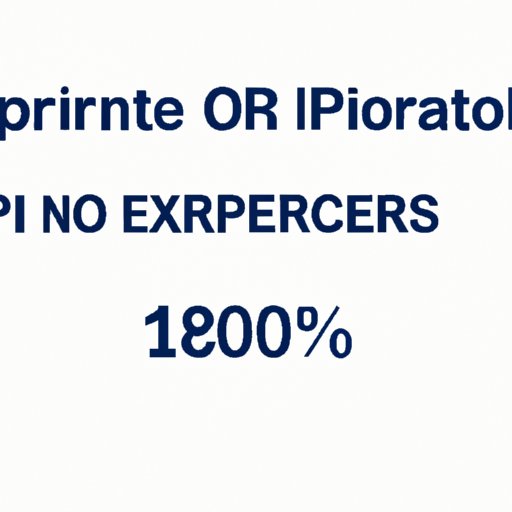I. Introduction
Percent error is a calculation used to determine the accuracy of measurements and experimental results. It is an important concept in science, engineering, and other fields where precise calculations are necessary. This article aims to provide a comprehensive guide to calculating percent error with accuracy and without common mistakes. By following the tips, examples, and explanations provided, the reader will be able to master the art of percent error calculation.

II. Avoid Mistakes and Calculate Percent Error Accurately With These Tips
Accurate percent error calculations are crucial, as they provide insight into the reliability of measurements and experimental results. The following tips can help avoid mistakes when calculating percent error:
1. Double-checking measurements and calculations
Mistakes can happen during measurements and calculations. Double-checking both can help avoid errors and provide more accurate results.
2. Using the correct formula
Using the wrong formula can lead to inaccurate results. It is important to use the correct formula for percent error calculations.
3. Converting units if necessary
Using different units can make calculations more complicated and lead to mistakes. To simplify calculations, it may be necessary to convert units to the same system.
Examples of common mistakes and how to avoid them
Some common mistakes in percent error calculation include:
- Using the wrong formula
- Misreading values on measuring instruments
- Forgetting to convert units
- Mistyping numbers during calculations
To avoid these mistakes, it is important to be attentive during measurements and calculations. Using the appropriate tools and double-checking values can also help avoid errors.
III. Step-by-Step Guide to Calculating Percent Error in Any Experiment
The following is a step-by-step guide to calculating percent error:
1. Determining the accepted value or theoretical value
The accepted value or theoretical value is the value that is expected from calculations, data, or experiments.
2. Measuring the experimental value
The experimental value is the value obtained from measurements or experiments.
3. Calculating the difference between the two values
Subtract the accepted value from the experimental value to obtain the difference.
4. Dividing the difference by the accepted value
Divide the difference by the accepted value.
5. Multiplying by 100 to get the percent error
Multiply the quotient by 100 to obtain the percent error.
Example of percent error calculation using the step-by-step guide
Suppose an experiment yielded a result of 22.0 grams, while the theoretical value is 24.0 grams. What is the percent error?
Step 1: Theoretical value = 24.0 grams
Step 2: Experimental value = 22.0 grams
Step 3: Difference = 24.0 grams – 22.0 grams = 2.0 grams
Step 4: Quotient = 2.0 grams / 24.0 grams = 0.0833
Step 5: Percent error = 0.0833 x 100% = 8.33%
IV. Common Percent Error Calculation Problems and How to Overcome Them
Percent error calculations can encounter problems with accuracy and precision. The following are examples of these problems:
1. Problems with accuracy
Accuracy refers to the correctness of measurements or calculations compared to the true value. The following problems can lead to inaccurate percent error calculations:
Incorrect measurements
Inaccurate measurements can lead to erroneous results. To avoid this, it is necessary to use accurate and calibrated measuring instruments.
Inaccurate instruments
Inaccuracies in instruments can lead to wrong measurements and wrong calculations. It is important to use the best and most accurate instruments available for the task.
2. Problems with precision
Precision refers to the consistency of measurements or calculations. The following problems can lead to imprecise percent error calculations:
Inconsistent measurements
Using different instruments or measurement techniques can lead to inconsistent measurements, which can give inconsistent percent error results.
Poor experimental design
Designing experiments poorly can lead to inconsistent measurements and calculations, which can give imprecise percent error results.
Tips for overcoming these problems
To overcome these problems, it is important to use accurate and calibrated instruments, design experiments well, and use consistent measurement techniques. Using averages or repeating measurements can improve precision, while double-checking measurements and calculations can improve accuracy.
V. Simplify Your Calculations: Tricks to Quickly Determine Percent Error
To simplify percent error calculations, the following tricks can be used:
1. Rounding to significant figures
Rounding to significant figures can simplify calculations while still keeping accuracy. It is important to be consistent with the number of significant figures used throughout the calculations.
2. Using scientific notation
Using scientific notation can make calculations easier by simplifying the representation of very large or very small numbers.
3. Pre-calculating some values
Pre-calculating some values, such as the accepted value or theoretical value, can make calculations faster and less error-prone.
Examples of simplified percent error calculations
Suppose the theoretical value is 50.0 grams, and the experimental value is 52.0 grams.
Example 1: Using rounding to significant figures
Step 1: Difference = 52.0 grams – 50.0 grams = 2.0 grams
Step 2: Quotient = 2.0 grams / 50.0 grams = 0.040
Step 3: Percent error = 0.040 x 100% = 4.0% (rounding to one significant figure)
Example 2: Using scientific notation
Step 1: Difference = 52.0 grams – 50.0 grams = 2.0 grams
Step 2: Quotient = 2.0 grams / 50.0 grams = 4.0 x 10^-2
Step 3: Percent error = 4.0 x 10^-2 x 100% = 4.0%
VI. Understanding the Concept of Percent Error: Examples and Explanations
Percent error is a useful concept in everyday life. The following are examples of percent error in different situations:
1. Cooking measurements
Cooking measurement errors can result in poor food quality. Percent error can be used to determine the accuracy of the measurements and improve the cooking process.
2. Temperature and weather predictions
Inaccurate weather predictions can lead to safety hazards. Percent error calculations can help improve the accuracy of predictions and keep people safe.
3. Sports statistics and rankings
Sports rely on accurate statistics and rankings. Percent error can be used to determine the precision and accuracy of sports statistics and rankings.
VII. Troubleshooting Percent Error: Common Errors and How to Fix Them
Common errors in percent error calculations include:
1. Incorrect formulas
Using the wrong formula can lead to inaccurate results. It is important to use the correct formula for percent error calculations.
2. Incorrect data entry
Mistyping numbers or copying values incorrectly can lead to wrong calculations. Double-checking data entry can help avoid this problem.
3. Misinterpretation of the results
Misinterpreting the results can lead to confusion or wrong conclusions. It is important to understand the meaning of percent error and use it correctly.
Tips for fixing these errors
To fix these errors, it is important to double-check data entry, use the correct formulas, and understand the meaning of percent error. Asking for help or consulting reputable sources can also be helpful.
VIII. Master the Art of Percent Error Calculation with These Effective Methods
Mastering percent error calculations requires practice, understanding, and attention to detail. The following tips can help:
1. Practicing with a variety of problems
Practicing with different types of percent error problems can improve accuracy and precision in calculations.
2. Understanding the importance of precision and accuracy
Understanding the difference between precision and accuracy can help in troubleshooting and improving calculations.
3. Checking your work
Double-checking measurements, calculations, and results can improve the accuracy of percent error calculations and avoid mistakes.
IX. Conclusion
Calculating percent error is an important concept in many fields and everyday life. By using the tips, step-by-step guides, and examples provided in this article, the reader can learn to calculate percent error accurately and avoid common mistakes. Practice and a good understanding of precision and accuracy are key to mastering percent error calculations.
Final advice: Remember to be attentive and meticulous when dealing with percent error calculations. Accuracy and precision are key to obtaining reliable and valid results.
